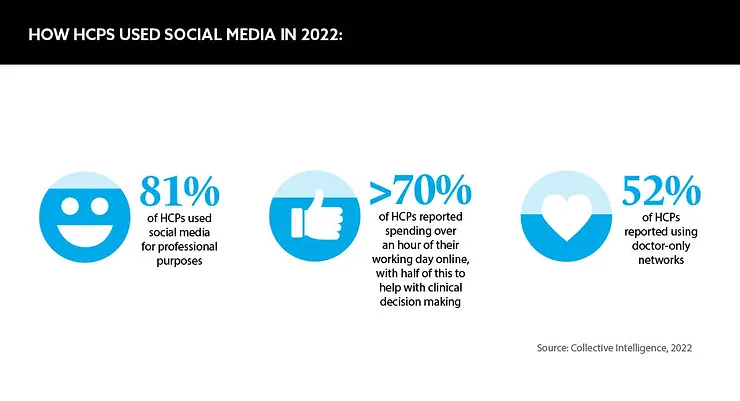Today’s medical affairs teams have larger roles to play in pharmaceutical companies’ commercialisation strategies than ever before. Leveraging social listening is one key way to keep ahead of the pack
Words by Saša Janković
With healthcare stakeholders across the spectrum actively using social media channels – from physicians and industry bodies to patients and policymakers – it pays for medical affairs professionals to keep an ear to the ground and stay up to date with the latest buzz and information surrounding a particular treatment or brand.
Fortunately, this does not involve holding upturned glasses to the wall to hear what is being said on the other side, or asking friends of competitor colleagues for the lowdown on what is going on over the fence. Rather, MA teams can monitor social media through social listening to keep abreast of trends that could inform wider organisational strategies.
Getting started
Social listening is as simple as identifying where relevant online conversations are happening – from Twitter and LinkedIn to online forums and discussion groups – then clicking follow and eavesdropping.
“Social listening can be boiled down to a simple statement: go to where your audience is and learn what they are saying,” states Dimithri Wignarajah, Vice President, Senior Director, Digital Communications Strategy, Healthcare Consultancy Group. He says companies should think of it as “an exercise in anthropology” as the tool provides an opportunity to gain insights through the power of observation and offers a route to raw information.
Go to where your audience is and learn what they are saying
But why is this necessary? These insights are valuable as they shed light on the behaviour and preferences of key stakeholders. According to Wignarajah, potential understandings include: “What motivates them? What excites or irritates them? What tools do they prefer? What do they want or need to do their jobs more effectively? How do they react to the latest news or data? What misconceptions might they have about a particular condition or product?” The list goes on.
Building on this, Robert Stevens, former Vice President and Global Head of Digital Medical Affairs, Novartis, says all the power and influence that social media has nowadays means social listening can be a “force multiplier” for MA – if done right.
Achieving success
Listening and learning is one thing, but MA needs to draw conclusions and set goals from the insights it gleans to truly add value to the wider business.
“Often, curiosity in customer engagement is lacking commitment, so an effective social listening strategy for medical affairs involves curiosity plus commitment to drive success,” explains Stevens. “Curiosity will open up what social sentiment is out there with customers or patients. The commitment part of the equation is a call to action to do something about it.” Social listening can help to shape strategies throughout the drug lifecycle, guiding medical teams on everything from product decisions to content calls.
“A bold medical affairs organisation should incorporate social listening into early pre-launch planning and as part of medical’s engagement strategy,” adds Stevens. “Insights generated through social listening can undoubtedly better inform launch strategies so pharma companies don’t waste time correcting market prep mistakes post launch.” The tool can also help companies to avoid creating campaigns that will fall flat and fail to drive high levels of prescription.
Nonetheless, it is important to remember that social listening should be used as an additional method of social monitoring and not as a complete replacement for other ways of engaging with customers, payers or patients. In other words, the approach has its limitations.
Social listening allows medical affairs to continually evolve its strategic position
“Social listening has long been a tool used to track conversations online, reflect community sentiment and identify trends – but this is limited,” stresses Julia Walsh, CEO, Brand Medicine International. “It is censored by what people feel comfortable posting using their personal handles – even within closed groups.” Still, this should not deter MA professionals from using social listening to shape medical, product or launch strategies as the opportunities far outweigh the drawbacks.
Further uses
The value of social listening continues post launch. Discussing its extensive reach, Stevens notes: “The great thing about a social listening plan for medical affairs is that it allows the function to keep its finger on the pulse from early pre-launch disease understanding through to post-launch,” he says. “It allows medical affairs to continually evolve its strategic position with stakeholders to ensure its efforts are focusing on truly winning for patients.”
And it’s not just HCPs and patients who can benefit. Optimised digital and social media engagement – including through making the most of what is learned through social listening – can help strengthen interactions with all healthcare sector stakeholders.
And, ultimately, as Pim Kooreman, Principal Consultant, Vintura, a healthcare and life sciences consultancy, says, the impact of social listening can extend far beyond an organisation’s MA team.
“Social media listening provides important insights for brand teams to further strengthen the overall strategy of products or therapeutic areas and should be leveraged cross-functionally,” she explains. Brand teams can use monitoring tactics to identify the strengths and weaknesses of competing products by observing conversations. MA needs to be at the forefront of social listening, but it should also be tapping other functions on the shoulder and telling them to take their glasses off the door and get a load of this.
Case study
Pim Kooreman, Principal Consultant, Vintura, a healthcare and life sciences consultancy, shares his recommendations for how medical affairs can leverage the power of social media
- Insights collection – Social listening enables companies to access vast swathes of information on demand
- Digital opinion leaders (DOLs) – DOLs offer the power to target stakeholders and reach new audiences
- True omnichannel engagement – Digital channels enable companies to meet customers where they are










